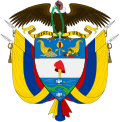Colombia–Philippines relations: Difference between revisions
grammar correction |
Rescuing 1 sources and tagging 0 as dead.) #IABot (v2.0.9.5 |
||
| (21 intermediate revisions by 16 users not shown) | |||
| Line 1: | Line 1: | ||
{{Infobox bilateral relations|Colombia-Philippines|Colombia|Philippines|map=Colombia Philippines.png}} |
|||
{{Infobox bilateral relations|Colombia–Philippines|Colombia|Philippines|}} |
|||
'''Colombia–Philippines relations''' refers to [[ |
'''Colombia–Philippines relations''' refers to [[bilateral relations]] between [[Colombia]] and the [[Philippines]]. Colombia has an embassy in [[Manila]]. The Philippines is accredited to Colombia from its embassy in [[Brasília]], [[Brazil]] and maintains an honorary consulate in [[Bogotá]].<ref name="businessmirror">{{cite web|url=https://businessmirror.com.ph/2019/06/27/colombian-envoy-enamorado-with-his-country-of-assignment/|title=Colombian envoy 'enamorado' with his country of assignment|author=Recto Mercene|website=businessmirror.com.ph|date=26 June 2019 |access-date=25 March 2022}}</ref> Both countries are predominantly Roman Catholic, and are [[Spanish Empire|former Spanish colonies]]. |
||
== History == |
== History == |
||
Relations between Colombia and the Philippines began before they became nations. For a time after the establishment of the [[Manila galleon|Manila Galleons]] that linked Latin America with Asia, Spain prohibited direct trade between the [[Viceroyalty of Peru]], which included [[Colombia]], and the [[Viceroyalty of New Spain]], which included the Philippines. However, illegal trade between Filipinos and Colombians continued in secret, as illegal Asian goods ended up in the markets of [[Córdoba Department|Córdoba, Colombia]], due to the collusion between Filipino, Peruvian, and Colombian merchants.<ref>In Spanish:[https://www.scielo.br/j/eh/a/Kkg4bMJrsbxJSCbKDwscqtd/?lang=en Conectando as Índias: o mundo hispano-asiático do Pacífico na História Global Moderna de Ryan Dominic Crewe]</ref> They settled and traded with each other while contravening royal mercantile laws.<ref>{{cite journal | url=https://www.degruyter.com/document/doi/10.1515/sai-2022-0008/html | doi=10.1515/sai-2022-0008 | title=El Galeón de Manila y el comercio de Asia: Encuentro de culturas y sistemas | journal=Interacción Sino-Iberoamericana / Sino-Iberoamerican Interaction | date=March 2022 | volume=2 | issue=1 | pages=85–109 | last1=Villamar | first1=Cuauhtemoc | doi-access=free }}</ref> Before the establishment of the First Filipino Republic, Colombians were seminal in the formation of the Philippines. Latin American officers from [[Gran Colombia]] were among the rebel soldiers supporting [[Andres Novales]], the brief Emperor of the Philippines, in his short-lived revolt against Spain.<ref>[http://adoborepublic.net/live-local-mexico/filipinos-in-mexican-history/filipinos-in-mexicos-history-4/ "Filipinos In Mexico's History 4 (The Mexican Connection – The Cultural Cargo Of The Manila-Acapulco Galleons)] {{Webarchive|url=https://web.archive.org/web/20200804134705/http://adoborepublic.net/live-local-mexico/filipinos-in-mexican-history/filipinos-in-mexicos-history-4/ |date=2020-08-04 }} By Carlos Quirino</ref> Also, the first winner of the [[Miss International]] female beauty pageant, Miss [[Stella Araneta|Stella Marquez]] of Colombia,<ref>{{cite news|title=Stella Araneta on Miss U:' I'm Colombian but I would choose Philippines'|url=http://www.rappler.com/life-and-style/specials/117637-stella-araneta-pia-wurtzbach-miss-universe-colombia|access-date=1 January 2016|publisher=Rappler|date=1 January 2016}}</ref> married Filipino [[Jorge Araneta]] (one of whose ancestors was [[Araneta family|Baltazar de Araneta]] of Mexico). Official relations between Colombia and the Philippines were established in 1959. Bilateral relations between the two nations remain healthy.<ref name="dfa">{{cite web|url=https://dfa.gov.ph/dfa-news/dfa-releasesupdate/10941-philippines-and-colombia-agree-on-ways-forward-to-deepen-bilateral-relations|website=dfa.gov.ph|title=Philippines and Colombia Agree On Ways Forward to Deepen Bilateral Relations |publisher=Philippine Department of Foreign Affairs |access-date=25 March 2022}}</ref> |
|||
==References== |
==References== |
||
{{Reflist |
{{Reflist}} |
||
==External links== |
|||
[[Category:Colombia–Philippines relations| ]] |
|||
* {{Commons category-inline}} |
|||
{{Foreign relations of Colombia}} |
|||
{{Foreign relations of the Philippines}} |
|||
{{DEFAULTSORT:Colombia-Philippines relations}} |
|||
[[Category:Bilateral relations of Colombia|Philippines]] |
[[Category:Bilateral relations of Colombia|Philippines]] |
||
[[Category:Bilateral relations of the Philippines]] |
[[Category:Bilateral relations of the Philippines]] |
||
{{Colombia-stub}} |
|||
{{Philippines-stub}} |
|||
Revision as of 06:21, 17 December 2023
 | |
Colombia |
Philippines |
|---|---|
Colombia–Philippines relations refers to bilateral relations between Colombia and the Philippines. Colombia has an embassy in Manila. The Philippines is accredited to Colombia from its embassy in Brasília, Brazil and maintains an honorary consulate in Bogotá.[1] Both countries are predominantly Roman Catholic, and are former Spanish colonies.
History
Relations between Colombia and the Philippines began before they became nations. For a time after the establishment of the Manila Galleons that linked Latin America with Asia, Spain prohibited direct trade between the Viceroyalty of Peru, which included Colombia, and the Viceroyalty of New Spain, which included the Philippines. However, illegal trade between Filipinos and Colombians continued in secret, as illegal Asian goods ended up in the markets of Córdoba, Colombia, due to the collusion between Filipino, Peruvian, and Colombian merchants.[2] They settled and traded with each other while contravening royal mercantile laws.[3] Before the establishment of the First Filipino Republic, Colombians were seminal in the formation of the Philippines. Latin American officers from Gran Colombia were among the rebel soldiers supporting Andres Novales, the brief Emperor of the Philippines, in his short-lived revolt against Spain.[4] Also, the first winner of the Miss International female beauty pageant, Miss Stella Marquez of Colombia,[5] married Filipino Jorge Araneta (one of whose ancestors was Baltazar de Araneta of Mexico). Official relations between Colombia and the Philippines were established in 1959. Bilateral relations between the two nations remain healthy.[6]
References
- ^ Recto Mercene (26 June 2019). "Colombian envoy 'enamorado' with his country of assignment". businessmirror.com.ph. Retrieved 25 March 2022.
- ^ In Spanish:Conectando as Índias: o mundo hispano-asiático do Pacífico na História Global Moderna de Ryan Dominic Crewe
- ^ Villamar, Cuauhtemoc (March 2022). "El Galeón de Manila y el comercio de Asia: Encuentro de culturas y sistemas". Interacción Sino-Iberoamericana / Sino-Iberoamerican Interaction. 2 (1): 85–109. doi:10.1515/sai-2022-0008.
- ^ "Filipinos In Mexico's History 4 (The Mexican Connection – The Cultural Cargo Of The Manila-Acapulco Galleons) Archived 2020-08-04 at the Wayback Machine By Carlos Quirino
- ^ "Stella Araneta on Miss U:' I'm Colombian but I would choose Philippines'". Rappler. 1 January 2016. Retrieved 1 January 2016.
- ^ "Philippines and Colombia Agree On Ways Forward to Deepen Bilateral Relations". dfa.gov.ph. Philippine Department of Foreign Affairs. Retrieved 25 March 2022.
External links
 Media related to Relations of Colombia and the Philippines at Wikimedia Commons
Media related to Relations of Colombia and the Philippines at Wikimedia Commons


